Troubleshooting Tomato Plant Problems with Joe Lamp’l
When we begin our gardens, we imagine what our tomato harvest will look like. But most of the time, we don’t anticipate tomato plant problems that often arrive in mid-summer.
Beginning gardeners blame themselves and sometimes give up. But they shouldn’t. Summer tomato problems are more common than you realize, and thankfully, there are steps you can take to overcome many of these tomato issues.
In this episode of the Beginner’s Garden Podcast, gardening expert Joe Lamp’l of the Joe Gardener Show offers solutions to these common tomato problems in the home garden. Don’t forget to listen to my other interviews with Joe about organic fertilizer options and organic pesticides.
Click below to listen or continue reading.
Common Tomato Plant Problems
We all get discouraged when faced with these tomato plant problems: blossom end rot, tomato plants outgrowing their trellis, and no fruit production. Below are ways to prevent and treat these issues, along with a suggestion on how to keep your harvest going all season!
Blossom End Rot: What it is and how to fix it
Blossom end rot is an ugly black spot on the blossom end of the tomato (the bottom end, opposite where the tomato fruit meets the stem) that often shows up on the first few ripe tomatoes of the year.

While you may have heard that a lack of calcium causes blossom end rot, for most gardens, it isn’t a lack of calcium in the soil at all. Instead, more commonly, the problem is that the calcium present in the soil isn’t able to be transported properly into the plant.
How do you prevent blossom end rot?
Although many people suggest adding epsom salt to the tomato plant, this step isn’t necessary, and can even make the problem worse. In addition, the solution isn’t to add eggshells or other calcium sources to the planting hole. Instead, the solution to blossom end rot is much simpler in most cases.
You need to make sure the plant is receiving consistent watering.
As long as your soil’s pH is in the proper range (Joe suggests a pH of 6.5 to 7.0), your soil has plenty of organic matter like compost (and thus plenty of calcium), and you water consistently, you should not have a problem with blossom end rot.
What do you do if blossom end rot has already struck your plant?
Same advice. Although the fruit already affected won’t recover, maintaining a consistent watering schedule will prevent the condition in future tomatoes.
Tomato Plants Too Tall (Outgrowing Tomato Trellis)
When your indeterminate tomatoes reach the top of your tomato cages, what do you do? You could leave your plants to grow over the cage and let them sprawl. Many people do this, but it isn’t without its risks. As the weight of the fruit pull down on the vine, the vine could kink and possibly break.
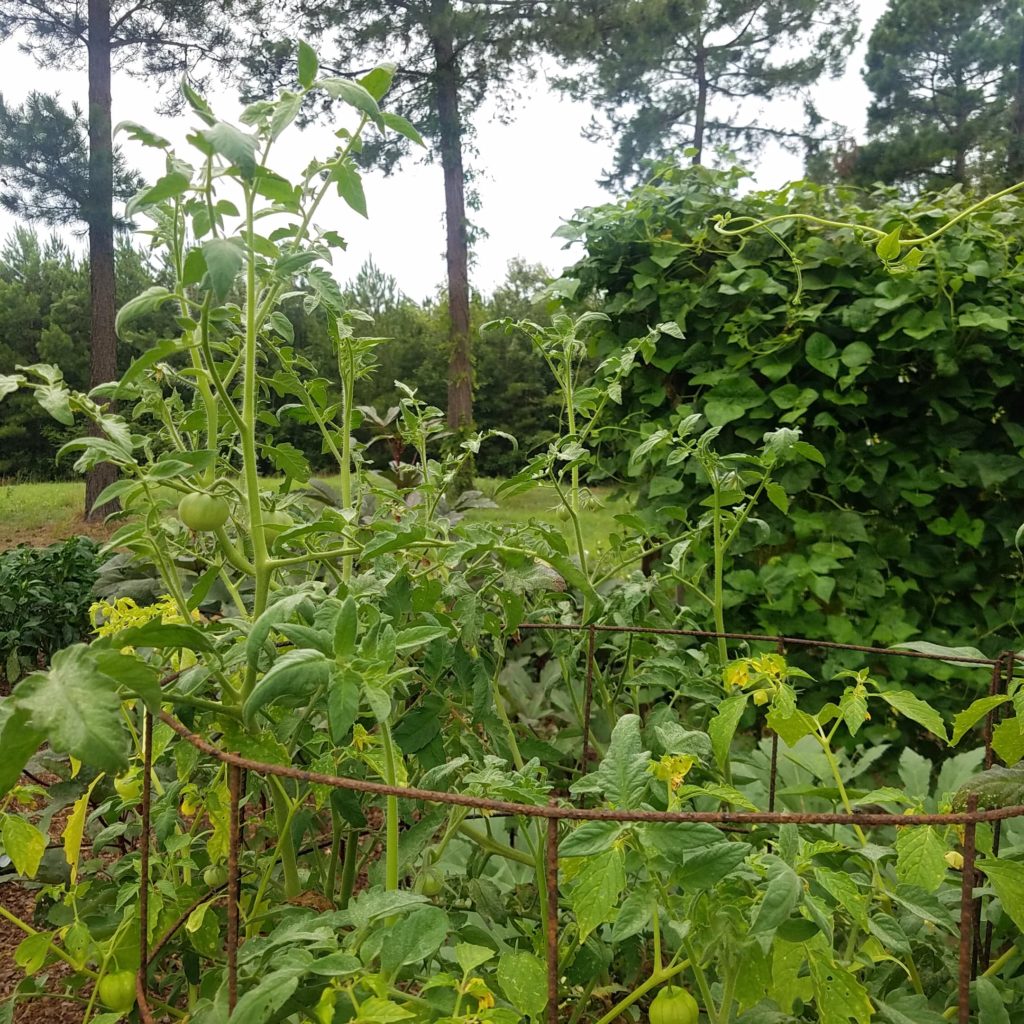
One solution is to top the plants by cutting the vine. This sacrifices some good blossoms that could produce fruit, but this practice does help control the sprawl.
An idea Joe suggests is to find the last blossom set that you want to keep and cut just above the next set of leaves up the plant. By keeping those leaves above the blossom, you create shade for the developing fruit and prevent sunscald.
*links below may contain affiliate links
Tomato Plants Not Producing Fruit
If your tomato plants are beautiful and full of green leaves but they don’t form many flowers and rarely produce fruit, you could have one of two problems going on.
Too Much Nitrogen for Tomatoes
One, the soil in which the tomato plants grow may contain too much nitrogen. It is common for beginning gardeners to over fertilize their garden. While the nitrogen helps produce green leaves, tomato plants subsequently need phosphorus to form flowers and fruit.
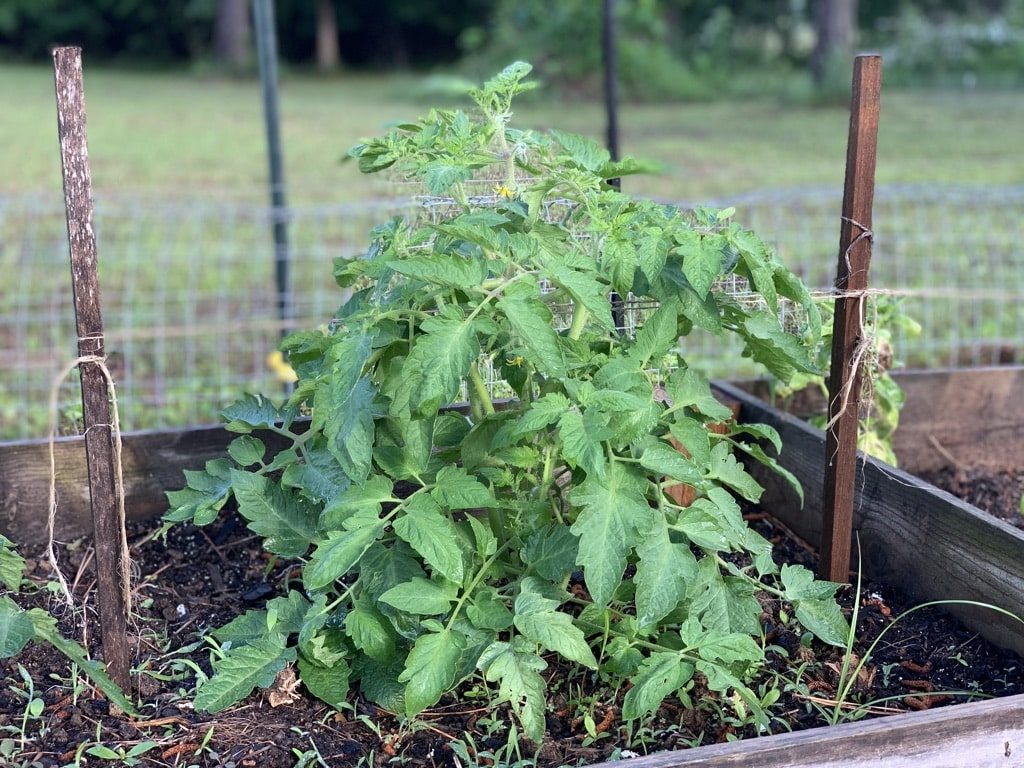
What to do if there’s too much nitrogen in the soil for tomatoes?
If you suspect too much nitrogen in the soil, stop adding any form of high-nitrogen fertilizer. Instead, use organic fertilizer high in phosphorus like this one.
Weather Too Hot for Tomato Flowers and Fruit
Before assuming your soil has too much nitrogen, though, consider your recent weather.
Sometimes, it is just too hot for tomatoes. If it gets hotter that 90* F in the daytime and the nighttime temperatures stay in the upper 70s* F, the plant can shut down and temporarily stop producing fruit.
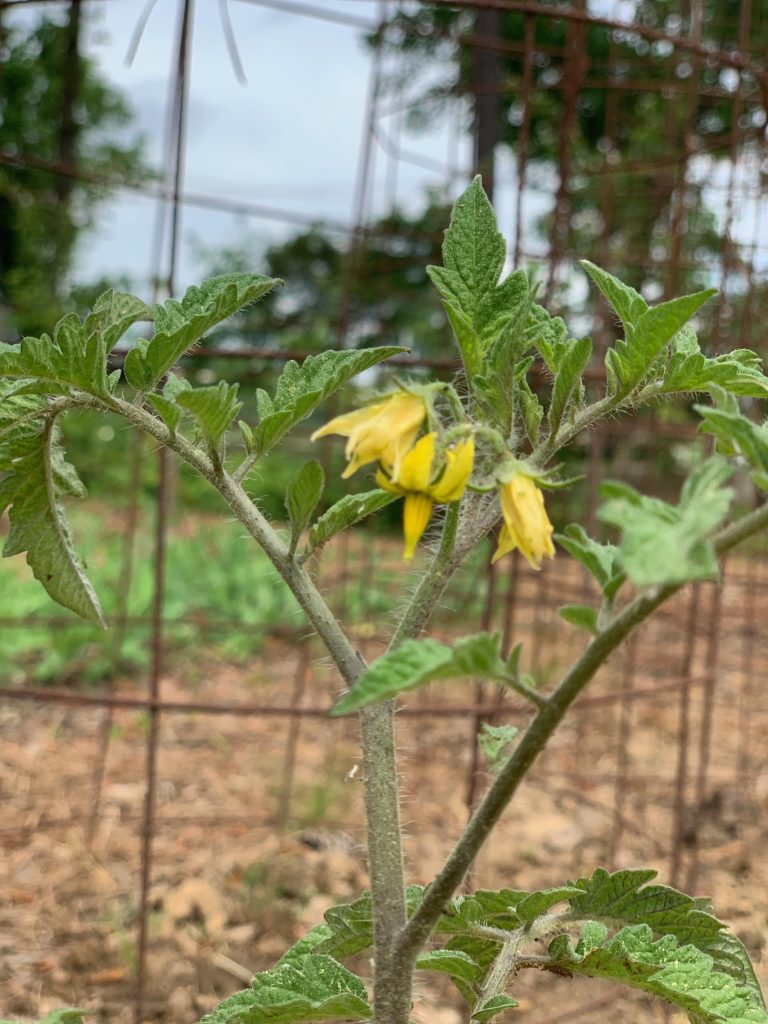
What to do if tomatoes stop producing fruit in the summer heat?
Fortunately, tomato plants rebound quickly once temperatures moderate. As long as you can keep the plant healthy, watered, and free of disease and pests that threaten it through the heat of the summer, you will likely find yourself a new harvest in the late summer and early fall. Just baby those babies until then as much as you can.
How to Start a New Mid-Summer Tomato Crop
What happens if your tomatoes begin to look worn out around mid-summer? Or maybe, like I experienced in 2018, they’re losing the the battle with disease? Are you done with tomatoes for the season? Joe says no. He suggests — if you’re up for it — start a new crop!
But in his method, you don’t start from seed all over again. Instead, you begin new tomato plants from the old ones. How do you do that?
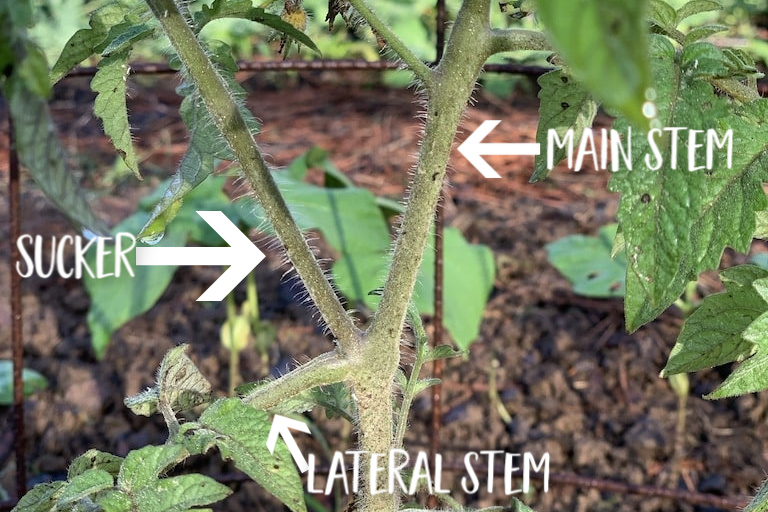
You can prune some of your suckers, and place them in pots, and let them take root. Make sure that the soil is plenty moist so that the roots will grow well. Joe puts water in a solid tray and puts the pot into the tray so that it always has plenty of water. After the plant becomes established (usually in about a month), you can transplant into your garden.
This second planting extends the tomato harvest and they may escape some of the disease pressure that the first planting experienced.
Final Thoughts on Common Tomato Plant Problems
As Joe and I agreed in the beginning of this podcast episode, growing tomatoes isn’t always easy. In fact, it’s rarely ever easy! Even the most veteran gardeners experience down years and fight many of the most common tomato plant problems.
Hopefully through this post and podcast, you feel more equipped to tackle many of those issues and grow a bumper crop of tomatoes!
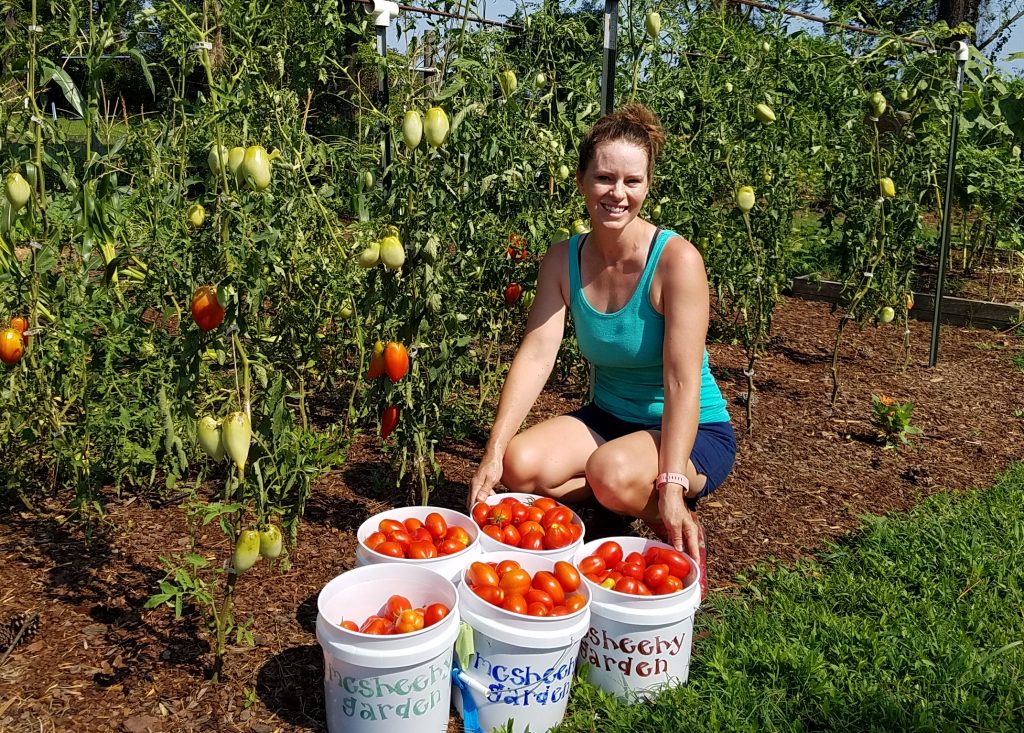

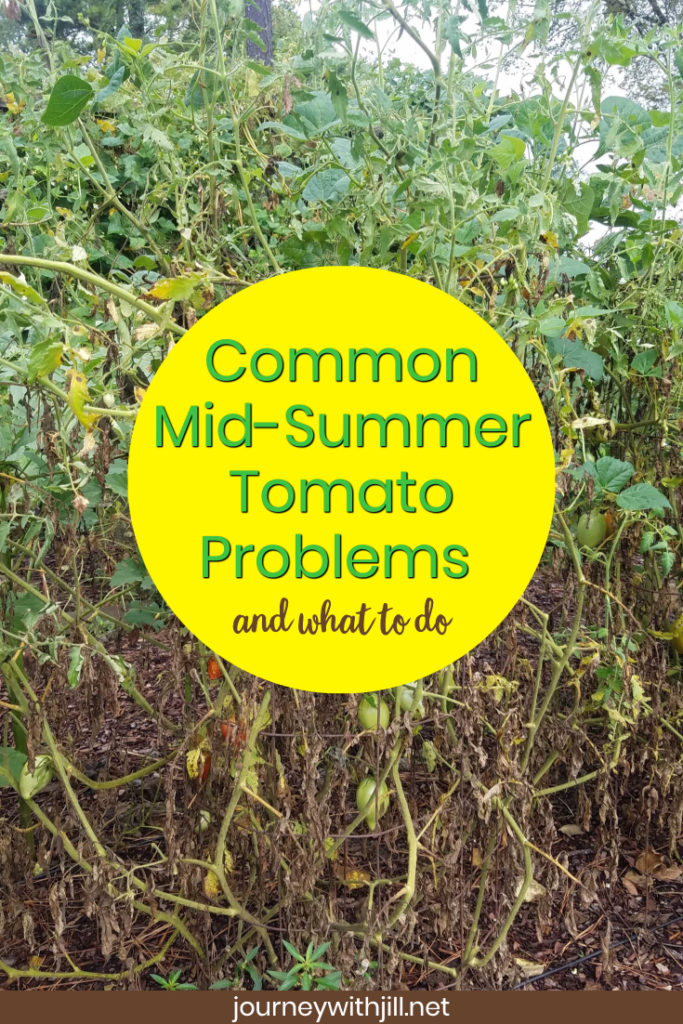
Your article was very informative, I’ve already ripped out a high bred tomato plant (purple something) with curling leaves, had it from the start, so far my early girl and black cherry seem ok, but I do occasionally see blossoms turning brown and dropping off???
The blossoms that turn brown and drop off are getting too hot to pollinate. This is called “blossom drop.” There’s really not much you can do about it except keep the plant as healthy as possible until the temperatures moderate. Depending on the variety, blossoms will start dropping when daytime temps exceed the mid 90s and nighttime temps stay in the upper 70s or higher. Some varieties withstand hotter temperatures better than others, and it might help in future years to test some and plant the ones with greater tolerance for heat.
My tomatoes have no taste & are mealy. When I pick them they are beautiful & perfect looking but within a day or two they have a couple of tiny bad spots & they grow uglier by the day & the spots get bigger. What am I doing wrong? I have worked hard for nothing.
I suspect — but it’s hard to know without seeing it — that your tomatoes might be incurring damage from a piercing insect, such as a stink bug. This will cause spots that grow and will affect the fruit. I recommend picking the tomato at the “breaker stage,” which Joe talks about in this podcast interview. It’s when the first blush of the tomato arrives. This should beat any of the insects wanting to taste test your tomato. Let it ripen on the counter for a couple of days, and see if that helps. Also, in my experience, some varieties of tomatoes have a more mealy texture than others, but since you’re describing bad spots, I imagine the issue probably isn’t the variety. Hope this helps.
I bought two large cherry tomato plants to grow in containers. Their lower leaves are turning yellow and some are brown. Now as I look more leaves are being effected further up the stem. They are watered daily – soil not being too saturated. I am worried about my plants and don’t know what to do for them.
I’m not sure; I personally have very limited experience growing tomatoes in containers. This resource might help you identify the problem: https://www.missouribotanicalgarden.org/gardens-gardening/your-garden/help-for-the-home-gardener/advice-tips-resources/visual-guides/tomato-foliage-problems.aspx
But my first guess is that if you haven’t cut off the yellowing/browning leaves at the bottom of the plant, it could be early blight, which travels up the plant if not trimmed off quickly.
This is my first year to have a garden. My Big Boy tomatoes have some leaf miners. I keep pinching off the leaves as soon as I see them. I’ve noticed a couple of leaves on my purple tomato plants (can’t think what they are called at the moment) have them, so I’m pinching those off too. The Big Boy plants are very leggy and the leaves are curling. We have the whole garden (raised bed) on a drip system, so I know they are getting water. Any idea what the issue might be? Should I just pull the Big Boys and try something else?
I’ve noticed leaf miners more this year myself, but from what I can read, you’re doing the right thing in pinching the leaves off. I’m not sure about curling of leaves — this could be a lot of different things. Some varieties are more prone to curling; with others it could indicate a problem like herbicide damage, nutritional deficiency, disease, or something else entirely. This site might help narrow it down: https://www.missouribotanicalgarden.org/gardens-gardening/your-garden/help-for-the-home-gardener/advice-tips-resources/visual-guides/tomato-foliage-problems.aspx
After battling a number of virus and mold issues I have decided to pull all the plants from my box and try to give the soil a rest. What can I do to help the soil get cleared of all the bad stuff. Would it help if I put a black tarp over it to let the sun “cook” out all the bad bacteria and mold?
You’re thinking the right thing, but instead of a black tarp, from what I understand, you need a clear tarp. Look up “soil solarization” for exact instructions. I definitely would recommend adding compost (preferably not homemade, just in case the virus issues persist in some of your material) to get the soil from a sterile state to a state where beneficial microorganisms thrive.